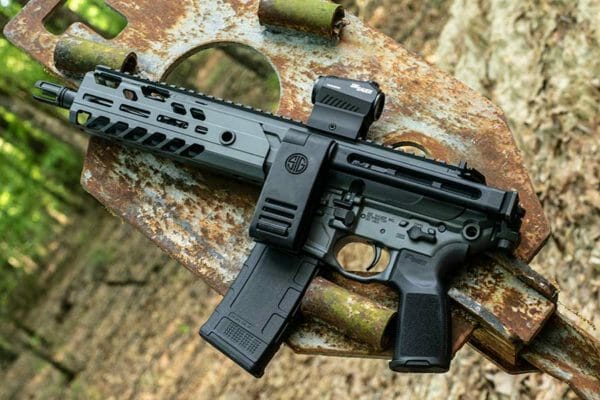

A Texas Federal District Judge vacated the Bureau of Alcohol, Tobacco, Firearms and Explosives’ (ATF) Final Rule for pistol stabilizing devices.
At the request of President Joe Biden, ATF introduced a new rule that reclassified pistols equipped with pistol stabilizing devices. The new classification considered pistol braces stocks. Therefore, any pistol with a brace would be viewed as a short-barreled rifle (SBR). Since any rifle with a barrel under 16 inches is regulated under the National Firearms Act of 1934 (NFA), anyone with a brace installed on a pistol would have to register their firearm with the ATF. Failure to do so would mean that the owner could be committing a felony in the eyes of the ATF. The penalty for violating the NFA could land a person in prison for ten years and force them to pay a $250,000 fine. This fine and sentence is the same punishment for having an unregistered machine gun.
Before the rule was enacted, several gun organizations filed for injunctions preventing the ATF from enforcing the rule. All these gun rights organizations received injunctions. Eventually, a nationwide injunction would be issued. One of these cases was Mock v. Garland, filed by the Firearms Policy Coalition (FPC). After an original loss, FPC would appeal to the Fifth Circuit Court of Appeals, where a panel of three judges would rule that the organization was entitled to a preliminary injunction and remanded the case back to the District Court level.
Both the Plaintiffs and the Defendants asked District Court Judge Reed O’Connor for summary judgment. The ATF wanted the Court to allow the rule to be enforced. FPC wanted the rule to be completely struck down. The ATF claimed that the Fifth Circuit’s decision did not bind the District Court’s decision. Judge O’Connor said that even if that was the case, he agreed with the Fifth Circuit’s reasoning.
“Defendants assert that it would be proper for the Court to make its own determination on the issue because this Court is not bound by the Fifth Circuit’s opinion, the briefing was insufficient at the appellate level, and the panel created a new legal test for determining whether a rule is legislative,” Judge O’Connor wrote. “The Court declines to relitigate a determination made by the Fifth Circuit in this case. Even assuming that this Court is not bound by the majority’s opinion, and that the majority created a new test for determining whether a rule is legislative in nature, the Court has previously adopted the majority’s conclusion as its own.”
The ATF’s lawyers tried to argue that the plaintiffs were not eligible for an injunction because of the Tax Anti-Injunction Act (AIA). The AIA states, “[n]o suit for the purpose of restraining the assessment or collection of any tax shall be maintained in any court by any person, whether or not such person is the person against whom such tax was assessed.”
Judge O’Connor said he did not have to consider the AIA because he would not issue an injunction. Instead, the Judge was going to vacate the law, which is not covered by the AIA. The court ruling not only enjoined the ATF from enforcing the rule; it knocked the rule down entirely.
The Judge also decided the rule violated the Administrative Procedures Act (APA). The ATF tried to argue that the Final Rule was a logical outgrowth of the proposed rule that the public could comment on during the open comment period. The Plaintiffs argued that the Final Rule bore no resemblance to the proposed rule. The Judge agreed with the Plaintiffs.
“Consequently, the Court finds that the Final Rule violated the APA’s procedural requirements because it was not a logical outgrowth of the Proposed Rule,” the order read. “Accordingly, Plaintiffs’ Motion for Summary Judgment is GRANTED and Defendants’ Motion for Summary Judgment is DENIED as to this issue.”
Judge O’Connor also agreed that the adaptation of the Final Rule was arbitrary and capricious. He said the Bureau did not provide a detailed justification for changing years of policy. Most believed that the ATF changed its long-standing position on pistol stabilizing devices to placate President Joe Biden. President Biden demanded that the ATF change the rule to restrict pistols equipped with stabilizing devices. The Judge also said the ATF did not take into consideration the public’s comments when creating the Final Rule.
The Judge also was concerned that the ATF could not explain how the Bureau classifies pistols with braces as SBRs. This problem means that no one could know if they possessed a pistol with a stabilizing device or an unregistered SBR until the ATF charged them with a felony. He pointed out that no one could identify a pistol with a brace that the ATF wouldn’t consider an SBR. The Judge said the rule was “impermissibly vague.”
“Under the Final Rule, the ATF estimated about 99% of pistols with stabilizing braces would be reclassified as NFA rifles,” the order reads. “The ATF contemporaneously issued approximately sixty adjudications pursuant to the Final Rule that reclassified different configurations of firearms with stabilizing braces as NFA rifles The ATF provided no explanations for how the agency came to these classifications and there is no ‘meaningful clarity about what constitutes an impermissible stabilizing brace.’ In fact, the Fifth Circuit “[could not] find a single given example of a pistol with a stabilizing brace that would constitute an NFA exempt braced pistol.”
Judge O’Connor didn’t consider the Constitutionality of the rule because there was enough to vacate the rule under the APA. The Judge could send the rule back to the ATF to be modified, but he chose not to take this action because the rule is beyond repair. He could also apply the ruling just to the Plaintiffs, but he decided to apply the vacatur nationwide.
The ATF is expected to appeal the decision to the Fifth Circuit Court of Appeals, but they have already lost on that level, and there is no reason to think that the Fifth Circuit will have a change of heart. Either way, the case will probably be heading to SCOTUS, but there is no guarantee that the High Court will grant cert. We will have a better idea of the future of this rule and others when SCOTUS releases its opinion this month in Cargill v. Garland. That case deals with another ATF rule banning bump stocks.
About John Crump
John is a NRA instructor and a constitutional activist. Mr. Crump has written about firearms, interviewed people of all walks of life, and on the Constitution. John lives in Northern Virginia with his wife and sons. Follow John on Twitter at @crumpyss, or at www.crumpy.com.

This article was originally published by AmmoLand. We only curate news from sources that align with the core values of our intended conservative audience. If you like the news you read here we encourage you to utilize the original sources for even more great news and opinions you can trust!










Comments